
A slasher film is a subgenre of horror films involving a killer or a group of killers stalking and murdering a group of people, usually by use of bladed or sharp tools. Although the term "slasher" may occasionally be used informally as a generic term for any horror film involving murder, film analysts cite an established set of characteristics which set slasher films apart from other horror subgenres, such as monster movies, splatter films, supernatural and psychological horror films.

Snuff is a 1976 splatter film directed by Michael Findlay and Horacio Fredriksson. Originally an exploitation film loosely based on the 1969 murders committed by the Manson Family, it is most notorious for being falsely marketed as if it were an actual snuff film. The controversy about the film was deliberately manufactured to attract publicity: it prompted an investigation by the New York County District Attorney, who determined that the murder shown in the film was fake. This picture contributed to the urban legend of snuff films, although the concept did not originate with it.

Zombi 2 is a 1979 Italian zombie film directed by Lucio Fulci, from a screenplay by Elisa Briganti and an uncredited Dardano Sacchetti, and starring Tisa Farrow, Ian McCulloch, Richard Johnson, Al Cliver, Auretta Gay and Olga Karlatos. It serves as an unofficial sequel to George A. Romero's Dawn of the Dead (1978), which was released in Italy under the title Zombi.
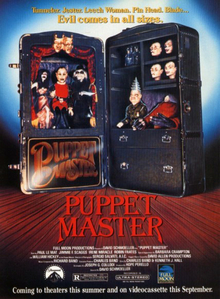
Puppet Master is a 1989 American horror film written by Charles Band and Kenneth J. Hall, and directed by David Schmoeller. The film stars Paul Le Mat, Irene Miracle, Matt Roe and Kathryn O'Reilly as psychics who are plotted against by a former colleague, using puppets animated by an Egyptian spell.

Humongous is a 1982 Canadian slasher film directed by Paul Lynch, and starring Janet Julian, John Wildman, and David Wallace. The story centers on a group of young adults who become stranded on a deserted island, where they are stalked and murdered by a monstrous assailant.

Night of the Demon is a 1980 American horror film directed by James C. Wasson, written by Jim L. Ball and Mike Williams, and starring Michael Cutt, Joy Allen, Robert Collings, Jodi Lazarus, Richard Fields, Michael Lang, and Melanie Graham. The film centers on an anthropologist who, along with a group of his pupils, embarks on an expedition to prove the existence of Bigfoot in a rural region of Northern California, only to be stalked and systematically slaughtered by the creature.
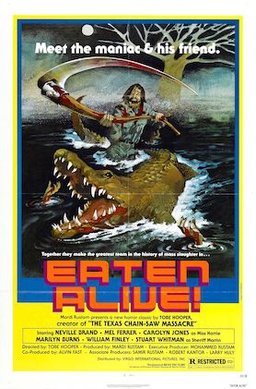
Eaten Alive is a 1976 American horror film directed by Tobe Hooper, and written by Kim Henkel, Alvin L. Fast, and Mardi Rustam.

Visiting Hours is a 1982 Canadian psychological slasher film directed by Jean-Claude Lord and starring Lee Grant, Michael Ironside, Linda Purl, William Shatner and Lenore Zann. The plot focuses on a feminist journalist who becomes the target of a serial killer, who follows her to the hospital after attacking her in her home.
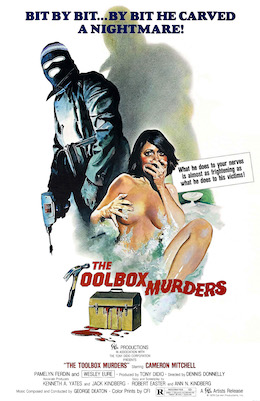
The Toolbox Murders is a 1978 American slasher film directed by Dennis Donnelly, from a screenplay by Neva Friedenn, Robert Easter, and Anne Kindberg. Starring Cameron Mitchell, Pamelyn Ferdin, and Wesley Eure. It follows a series of violent murders centered around a Los Angeles apartment complex, followed by the kidnapping and disappearance of a teenage girl who resides there. The film was marketed as being a dramatization of true events, though no source can confirm this. It was briefly banned in the early 1980s in the United Kingdom during the "video nasty" panic.

Blood Song is a 1982 American slasher film directed Alan J. Levi, produced by Frank Avianca and Lenny Montana, and starring Frankie Avalon and Donna Wilkes. It follows a crippled young woman in a coastal Oregon town who is stalked by a hatchet-wielding psychopath from whom she once received a blood transfusion. The movie is notable for a different style of performance from Avalon.
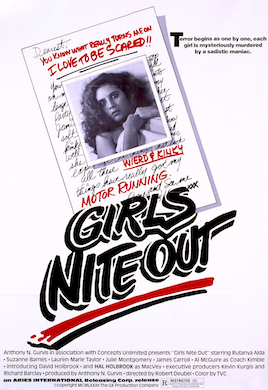
Girls Nite Out is a 1982 American slasher film directed by Robert Deubel, and starring Julia Montgomery, Suzanne Barnes, Rutanya Alda, Lauren-Marie Taylor, and Hal Holbrook. It focuses on a group of female college students who are targeted by a killer in a bear mascot costume during an all-night scavenger hunt on their Ohio campus.

Nightmare is a 1981 American psychological slasher film written and directed by Romano Scavolini, and starring Baird Stafford and Sharon Smith. Its plot follows a deranged man who, after undergoing an experimental medical procedure, is released from a New York City psychiatric hospital and embarks on a road trip to Florida with the intent of murdering his ex-wife and child.

The Dorm That Dripped Blood, originally released under the title Pranks, is a 1982 American slasher film directed by Stephen Carpenter and Jeffrey Obrow, written by Carpenter and Stacey Giachino, and starring Laurie Lapinski, Stephen Sachs, David Snow, Pamela Holland, and Daphne Zuniga in her film debut. It follows four college students who stay on campus over the Christmas holiday to clean out a condemned dormitory, where an unknown assailant begins stalking and murdering them.

Spookies is a 1986 American independent horror film directed by Brendan Faulkner and Thomas Doran, with additional footage directed by Eugenie Joseph. It stars Felix Ward, Dan Scott, Alec Nemser, and Maria Pechukas, and follows a group of partying adults who find an abandoned mansion and become trapped inside as a warlock tries to sacrifice the group with the intention of using their vitality to keep his wife alive.
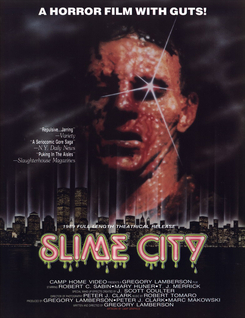
Slime City is a 1988 American science fiction comedy horror film written and directed by Greg Lamberson. It stars Robert C. Sabin, Mary Huner, Bunny Levine and Marilyn Oran.
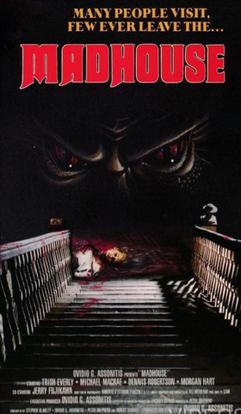
Madhouse is a 1981 Italian slasher film directed and co-written by Ovidio G. Assonitis, and starring Trish Everly, Dennis Robertson, Allison Biggers, and Michael Macrae. The plot follows a schoolteacher in Savannah, Georgia being stalked by her psychopathic twin sister in the days leading up to their birthday. The film's original title takes its name from a poem called "There Was a Little Girl" by Henry Wadsworth Longfellow.

Uninvited is a 1987 American science-fiction horror film written, produced and directed by Greydon Clark and starring George Kennedy, Alex Cord, Clu Gulager, Toni Hudson and Eric Larson. The film primarily takes place aboard a luxury yacht owned by a criminal multimillionaire and bound for the Cayman Islands, whose passengers and crew are terrorized by a mutant cat.

The Initiation is a 1984 American slasher film directed by Larry Stewart, and starring Daphne Zuniga, Vera Miles, Clu Gulager, and James Read. The plot focuses on a young woman plagued by a disturbing recurring nightmare, who finds herself and her fellow sorority pledges stalked by a killer during their initiation ritual in a department store after-hours.

Silent Night, Deadly Night is an American Christmas horror film series, consisting of six films. The first film in the series, Silent Night, Deadly Night (1984), originally titled Slay Ride, tells the story of Billy, a young man who experiences a psychotic break and goes on a murder spree dressed as Santa Claus. The film received theatrical distribution from TriStar Pictures, but was pulled from theaters in November 1984 after a series of protests against the film.



















